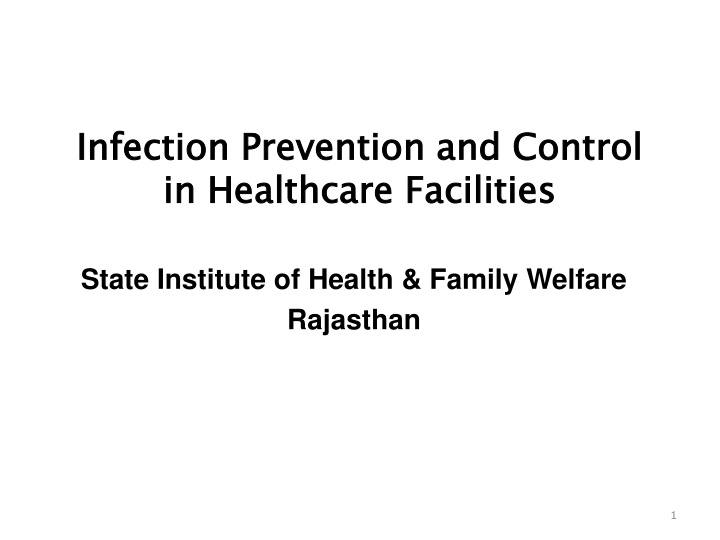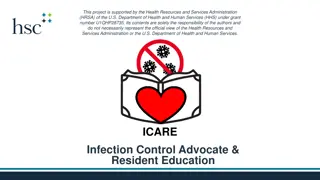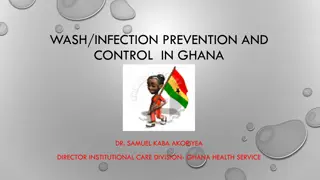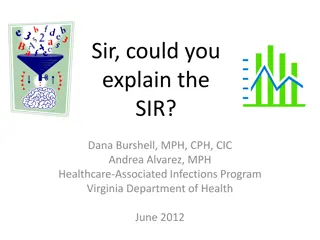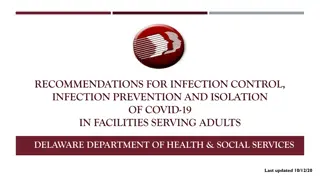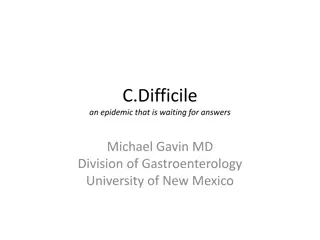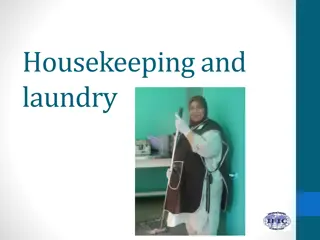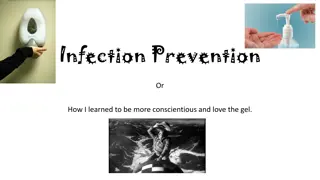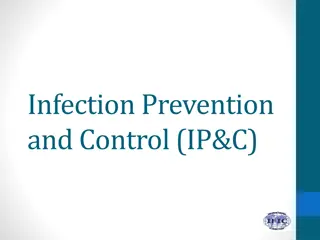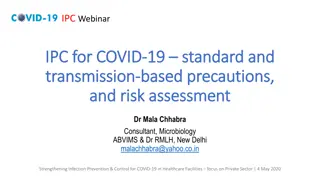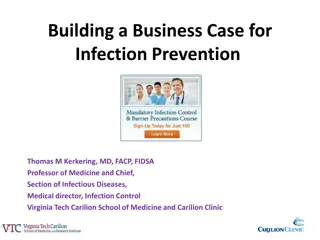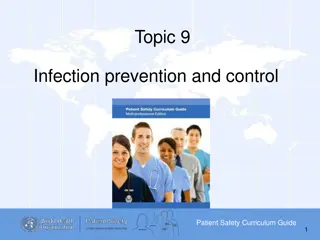Comprehensive Guide to Infection Prevention and Control in Healthcare Facilities
This comprehensive guide outlines the objectives, structure, responsibilities, common sources of infection, and principles of infection prevention and control in healthcare facilities. The program aims to minimize the risk of healthcare-associated infections, enhance healthcare worker adherence to IPC practices, and improve patient outcomes by reducing morbidity and mortality. Key components include establishing infection control teams, conducting surveillance, and developing annual IPC plans with budgets.
Download Presentation

Please find below an Image/Link to download the presentation.
The content on the website is provided AS IS for your information and personal use only. It may not be sold, licensed, or shared on other websites without obtaining consent from the author.If you encounter any issues during the download, it is possible that the publisher has removed the file from their server.
You are allowed to download the files provided on this website for personal or commercial use, subject to the condition that they are used lawfully. All files are the property of their respective owners.
The content on the website is provided AS IS for your information and personal use only. It may not be sold, licensed, or shared on other websites without obtaining consent from the author.
E N D
Presentation Transcript
Infection Prevention and Control in Healthcare Facilities Infection Prevention and Control in Healthcare Facilities State Institute of Health & Family Welfare Rajasthan 1
Objectives of the IPC programme Objectives of the IPC programme The objective is to minimize the risk of HAIs to patients, HCWs and visitors. This is achieved by Enabling and assisting all categories of HCWs to adhere to comprehensive IPC practices at all levels of care; and Providing safe and quality healthcare and improving outcomes by reducing morbidity and mortality. 2
Structure of IPC programme Hospital infection control committee Chairperson: Head of the institute Member-secretary/ infection control officer Member - Representation from management/ administration: Dean/ Director of hospital; nursing services; medical services; Representation from relevant medical and surgical disciplines R Representation from support services: operation theatre (OT), central sterile supply department (CSSD), housekeeping/ sanitation, laundry, engineering, pharmacology/ pharmacy, stores/ materials department R Infection control nurse (ICN) Structure of IPC programme operations R 3
Responsibilities Responsibilities Establish the IPC programme in the HCF Constitute an infection control team. Review and revise annually infection control guidelines with policies, recommendations and working protocols. Organize training programme Conduct and analyize surveillance of AMR and HAI Evaluate the effectiveness of interventions for IPC Prepare an annual IPC plan with a detailed budget. 4
Common sources of infection in HCF Common sources of infection in HCF Environment : Blood, body fluids, secretions, excretions, placenta, contaminated sharps and other equipments. Other clients and attendants Health care delivery personnel People in the community 5
Principles of Infection Prevention Principles of Infection Prevention All objects in contact with the client: Potentially contaminated Every person: Potentially infectious If an object is disposable: Discard as waste. If reusable: Prevent infection by decontamination cleaning, disinfecting or sterilizing 6
Standard Precautions 1. Hand hygiene Standard Precautions 2. Personal protective equipment 3. Respiratory hygiene and cough etiquette 4. Prevention of injuries from sharps 5. Safe handling of patient-care equipment 6. Principles of asepsis 7. Environmental infection control a. Patient placement b. Environmental cleaning c. Linen and laundry 7 d. Waste disposal
5 Moments of Hand washing 5 Moments of Hand washing 8
Steps of Hand Washing Steps of Hand Washing 9
PPE PPE includes Gloves, Medical masks, Goggles or a face shield, Gowns, as well as for specific procedures, respirators (i.e., N95) and aprons. 10
How to wear gloves How to wear gloves 11
How to remove gloves How to remove gloves 12
Steps in Wearing Mask Steps in Wearing Mask Wash hands and dry. Remove the clean mask from the container with clean hands. Ensure the mask is fitted properly. If glasses are worn, fit the upper edge of the mask under the glasses..A secure fit will prevent both the escape and the inhalation of micro- organisms around the edges of the mask and fogging of the eyeglasses. Precautions Avoid talking, sneezing, or coughing if possible. Masks cannot be worn with beards/unshaven faces. The mask should completely seal the face at all times to ensure effective filtering of micro-organisms 13
Respiratory hygiene and cough etiquette Respiratory hygiene and cough etiquette Cover mouth and nose with a tissue when coughing or sneezing. Dispose the tissue after use in the nearest waste container. Perform hand hygiene after contact with respiratory secretions and contaminated objects or materials. 14
If resources permit, HCFs should ensure the availability of materials such as tissues and foot- operated waste bins for adhering to respiratory hygiene and cough etiquette in waiting areas for patients and visitors. In the absence of handkerchief or tissues, patients should be instructed to cover their nose and mouth with their arm during coughing and sneezing. Provide conveniently located dispensers of ABHR. 15
Respiratory hygiene and cough etiquette Where sinks are available, ensure that water and soap for hand washing are available at all times. Posters elaborating cough etiquette and hand hygiene must be displayed. Posters in the local language should be put up at appropriate locations in HCF with instructions for patients / attendants to inform the healthcare staff if they have symptoms of respiratory infection And on how to practice respiratory hygiene and cough etiquette. Respiratory hygiene and cough etiquette 16
Standard Precautions: Proper Handling and Disposal of sharps Needles and syringes Use disposable needle and syringe ONLY ONCE. Always wear utility gloves while handling sharps Do not disassemble the needle and syringe after use. Do not recap, bend or break needles before disposal. Make needles unusable after single use by burning them in a needle destroyer Never burn syringes Standard Precautions: Proper Handling and Disposal of sharps 17
Safe handling of patient equipment Equipment that has been soiled with blood or body Safe handling of patient- -care equipment care fluids should be decontaminated and cleaned to prevent transfer of microorganisms to other patients and the environment. Cleaning of patient-care areas and equipment should be carried out by a team of dedicated personnel trained in the appropriate cleaning procedures. Responsibility and accountability for cleaning should be assigned. 18
Safe handling of patient equipment Safe handling of patient- -care equipment care A hospital disinfection policy should be prepared for appropriate cleaning, sterilization of patient-care devices that come in contact with mucous membranes and access sterile tissues. The policy should be strictly followed and monitored. Accountability and responsibility should be assigned. disinfection and 19
Safe handling of patient equipment Safe handling of patient- -care equipment care A new equipment or serviced and repaired equipment should be cleaned and disinfected before patient use as per hospital policy. Heavy duty or strong utility gloves must be worn during decontamination, disinfection of instruments. Soiled patient-care equipment should be handled in a manner that prevents exposure of skin and mucous membranes and contamination of clothing and environment. cleaning and 20
Safe handling of patient equipment Safe handling of patient- -care equipment care Disposable patient-care equipment should not be reused and must be discarded into an appropriate container in accordance with the hospital waste management policy and the Biomedical Waste Management and Handling Rules 2016, 2018. Patient-care supplies (e.g. lotion, cream, soap) shall not be shared by patients 21
Principles of asepsis Patient placement in ward Spacing between beds should be 1 2 metres. Single rooms Single rooms reduce the risk of transmission of infection from the source patient to others by reducing direct or indirect contact transmission. Single rooms should have: Hand-washing facilities Toilet and bathroom facilities. Anterooms Single rooms used for isolation purposes may include an anteroom to support the use of PPE. Principles of asepsis 22
Standard Precautions: Processing of Used Items Standard Precautions: Processing of Used Items A. Decontamination B. Cleaning C. Sterilization or high level disinfection (HLD) D. Storage 23
Decontamination & Cleaning Decontamination & Cleaning Preparation of Chlorine Solution Decontamination of Operating Surfaces Decontamination of Instruments after use Cleaning of Instruments Contact Time for Decontamination 24
Steps of processing instruments and other items Steps of processing instruments and other items Decontamination (Soak in 1% chlorine solution 10 minutes) Cleaning with brush, detergent and water Preferred Method Acceptable Method Autoclave 15lbs/In2 pressure 121 C, (250 F) 20 min/30 min Sterilization HLD Chemical Soak in Glutaraldehyde (2%) for 20 min. Rinse with boiled for 20 min Chemical Soak in Glutaraldehyde (2%) for 8 hrs, Rinse with sterile water Boiling Lid on 20 minutes Cool, dry and Store 26
Spill Management Spill Management Wear appropriate PPE Place absorbent material on spill Apply Disinfectant Dispose the Contaminated Material Disinfect the spill area again Clean the equipment Remove Personal protective equipment Wash your hands Report the spill 27
Standard Precautions: Maintaining Clean Environment Type of cleaning solution Standard Precautions: Maintaining Clean Environment Uses To remove dirt & organic material such as grease, oil Plain detergent and water To clean up spills of blood or other body fluids Disinfectant 0.5 % chlorine solution For cleaning areas operation theatres, procedure rooms , latrines Disinfectant cleaning solution 28
Area/Items Item/Equipment Process Method/Procedure Clinical Area Sweeping Cleaning Daily mopping General clinical areas Dust mops ( no broom will be used for Sweeping)- Sweep with the dust mop or Mop Cleaning damp mop to remove surface dust. Sweep under the furniture and remove dust from corners. Gathered dust must be removed using the hearth brush and shovel The seep tool should be cleaned or replaced after used 29
Process Area/Items Item/Equipment Method/Procedure Clinical Area Prepare detergent with warm water Use the Three buckets technique for mopping the floor, one bucket with plain (one with plain water and one with the water and one detergent solution First mop the area with the water and detergent solution. After mopping clean the mop in plain water and squeeze it. Repeat this procedure for the remaining area. Mop area again using sodium hypochlorite 1% after drying the area. In between mopping if solution or water is dirty change it frequently. Mop the floor starting at the far corner of the room and work towards thedoor. Clean articles between cleaning. Note: Mopping should be done twice a day 30 cleaning solution using Floors (clinical areas) daily mopping Detergent/ sanitizer hot water, sodium hypochlorite(1%) Three-bucket( one with plain water and one with detergent solution; one bucket for sodium hypochlorite(1%)
Area/Items Item/Equipment Process Method/Procedure Clinical Area Damp dusting Ceiling and Walls Sweeping tool Duster Bowl/ small bucket of soap solution Plain water Damp dusting with a long handled tool for the walls and ceiling done with very little moisture, just enough to collect the dust. Damp dusting should be done in straight lines that overlap one another. Change the mop head/cover when soiled. Note: Should be done once a week or after examining a suspect case Care of mop Hot water Detergent Sodium hypochlorit e 1% Clean with hot water and detergent solution, disinfect it with sodium hypochlorite and keep for drying up side down. 31
Area/Items Item/Equipment Process Method/Procedure Clinical Area Thorough washing Doors and door knobs Damp cloth or Sponge squeeze mop detergent The doors are to be washed with s a brush, using detergent and water once a week (on one defined day); gently apply cloth to soiled area, taking care not to remove paint, then wipe with warm water to remove excess cleaning agent. Door knobs and other frequently touched surfaces should be cleaned daily Before cleaning an isolation room, liaise with infection control team for details of any special requirements. Staff will be instructed on specific cleaning procedures required with reference to Safety uniform to be worn Chemicals or disinfectants to be used. Also, if bed screen and shower screen are to be cleaned or changed, refer cleaning in isolation rooms Isolation room Detergent/ Sanitizer warm water, sodium hypochlorite (1%) Three buckets (one with plain water and one with detergent solution); . separate bucket for sodium hypochlorite (1%) Terminal cleaning 32
Area/Items Item/Equipment Process Method/Procedure Clinical Area Thorough washing Doors and door knobs Damp cloth or Sponge squeeze mop detergent The doors are to be washed with s a brush, using detergent and water once a week (on one defined day); gently apply cloth to soiled area, taking care not to remove paint, then wipe with warm water to remove excess cleaning agent. Door knobs and other frequently touched surfaces should be cleaned daily Before cleaning an isolation room, liaise with infection control team for details of any special requirements. Staff will be instructed on specific procedures required with reference to Safety uniform to be worn Chemicals or disinfectants to be used. Also, if bed screen and shower screen are to be cleaned or changed, refer cleaning in isolation rooms Isolation room Detergent/ Sanitizer warm water, sodium hypochlorite (1%) Three buckets (one with plain water and one with detergent solution); . separate bucket for sodium hypochlorite (1%) Terminal cleaning cleaning 33
Area/Items Item/Equipment Process Method/Procedure Sterthoscope Alcohol- based rub/ Spirit swab Cleaning Should be cleaned with detergent and water. Should be wiped with alcohol based rub/ spirit before each patient contact. swab BP cuffs and covers Detergent Hot Water Cleaning Cuffs should be wiped with alcohol- based disinfectant and regular laundering is recommended f thore cover. 34
Area/Items Thermometer Item/Equipment Process Method/Procedure Should be stored dry in individual holder. Clean with detergent and tepid water and wipe with alcohol rub in between patient use. Store in individual holder inverted. Preferably on e thermometer for each patient. Detergent and water Alcohol rub Individual thermomet er holder Cleaning 35
Area/Items Item/Equipment Process Method/Procedure Injection and dressing trolley Detergent and water Duster Disinfectant (70% alcohol) Cleaning To be Cleaned daily with detergent and water. After each use should be wiped with is infectant. Empty the fridge and store things appropriately. Defrost, decontaminate and clean with detergent. Dry it properly and replace the things. Weekly cleaning is recommended. Refrigerators Detergent and water Absorbent paper or clean cloth Cleaning ( Weekly) 36
Area/Items Item/Equipment Process Method/ Procedure Lodging area Daily mopping floors Thorough washing General cleaning Detergent and warm water Mop Two buckets Clean utility gloves Handmops Scrub floors with hot water and detergent with using minimal water. (Do not pour the water.) Clean with plain water. Allow to dry Hypochlorite 1% mopping can be done. Note: Recommend general cleaning procedure should be done twice a day Damp dust with warm water and detergent. Lockers, tables, cupboard, wardrobes, benches, shelves and cots Damp duster warm Water detergent dry duster Damp dusting 37
Area/Items Item/Equi pment Process Method/ Procedure Railings Detergent/ Sanitizer- hot water, sodium hypochlorite 1% Three small buckets / or big bowls one with plain water One with detergent solution One for sodium hypochlorite 1% Daily dusting Damp dust with warm water and detergent followed by disinfection with hypochlorite Mirrors and Glass Warm water Detergent water/Cleaning solution Damp Cloth wiper Cleaning Using warm Water and a Small quantity of detergent and using a damp cloth, wipe over the mirror and surround, then using a dry lint-free cloth, buff the mirror and glass to a clean dry finish. 38
Area/Items Item/Equipment Process Method/ Procedure Sluice room Stainless Steel/ Any other sink Powder cleanser Detergent powder wiper cloth Cleaning Sinks are to be cleaned with a powder cleanser. First wet the Sprinkleona little powder cleanser and work around the surface with a cloth , include the plughole. Do not use the powder clean seron dry sink. After removing spillage and any stains, flush away with running water. Wipe down the surface of the sink. b sink. 39
Area/Items Pantry furniture Item/Equipment Duster Process Dusting Method/ Procedure Damp dust Telephone Warm water detergent solution Duster General cleaning Damp dust with warm water and detergent. Paying special attention to theear and mouth plece and dry it properly. Wipe top sides and draw handles with a damp cloth. Wooden desks should be cleaned with furniture polish and buffed to clear glows. Pen holder etc. to be cleaned ordusted. Wipe down with warm water and detergent. Remove any marks under arms and seat. Check for damage to stoppers, if stopper require replacement, report to maintenance department. Desks Damp cloth furniture polish Dusting Chairs (Vinyl) Warm Water and detergent Cleaning 40
Area/Items Item/Equipment Process Warm water and detergent Rag piece Method/ Procedure Using Warm water and detergent, damp dust all furniture and fittings, including chairs, stools, beds, tables, cupboards, wardrobes, lockers, trolleys, benches, shelves and storage racks, waste/bins, fire extinguishers, oxygen cylinders, televisions window sills and dry properly. Wipe down over bed table. Wipe top and underneath base and stand, using warm water and detergent. Dry on completion. Wipe down the bedside. Remove marks form fronts of draws and sides. Using warm water and detergent, wash the top to remove any sticky marks and dust. Furniture and fittings Dusting Bed tables, bedside lockers Warm water and detergent wiper Duster Cleaning 41
Area/Items Item/Equipment Process Method/ Procedure Light Switches and over bed lights Damp cloth (never wet) detergent warm water Cleaning Light switches to be cleaned of dust, spots and finger marks. Clean with a damp cloth (never wet) and detergent. Over-bed lighting to be damp dusted. Clean with warm water and detergent. Curtains Soft clothes water mild soap solution Cleaning Clean with water and soap for curtains White clothes Sodium hypochlorite 1% tap water Washing Should be washed under running water and soaked in 1% sodium hypochlorite for 20 minutes. Note: PPE should be worn while washing soiled linen. 42
Area/Items Item/Equipment Process Method/ Procedure Mattress and pillow covers (cloth) Tap water Washing Mattress and pillows should be covered with a reusable mattress cover. It should be changed for each patient and when soiled sent to the laundry according to schedule. Mattress/ Pillow with rexin cover Normal/ without rexin Sodium hypochlorite 1% Sunlight Terminal Damp dusting and cleaning Drying in sunlight If with rexin cover, can be cleaned with 1% sodium hypochlorite before use for next patient If routine mattress, dry it in bright sunlight for 1-2 days before using for next patient Water jars Vim powder soap and water Cleaning Recommended boiled water for drinking Water jars should be Scrubbed/cleaned with soap and water and boiled water before filling with water. 43
Area/Items Item/Equipment Process Cleaning of toilets Toilet pot/ commode Sodium hypochlorite 1% Soap Powder / long handle angular brush Inside of toilet pot / commode: Scrub with the recommended agents and the long handle angular brush. Outside: Clean with recommended agents; use a nylon scrubber. Lid / commode Nylon scrubber and soap powder Wet and scrub with soap powder and the nylon scrubber inside and outside. Toilet floor Soap powder and scrubbing brush / nylon broom Scrub floor with soap powder and the scrubbing brush wash with water Use sodium hypochlorite 1% dilution 44
Area/Items Item/Equipment Process Method/ Procedure Tap Nylon scrubber and soap powder Wet and scrub with soap powder and the nylon scrubber Outside sink Soap powder and nylon scrubber Scrub with the nylon scrubber. Showers area / Taps and fittings Warm water Detergent powder nylon Scrubber Thoroughly scrub the floors/tiles with warm water and detergent Wipe over taps and fittings with a damp cloth and detergent. Care should be taken to clean the underside of taps and fittings. Taps should be dried after cleaning Soap dispensers Detergent and water Daily dusting Should cleaned weekly detergent and water dried. be with and Note: Dry the floors with a separate drying mop. 45
Standard Precautions: Maintaining Clean Environment Standard Precautions: Maintaining Clean Environment Clean and Disinfect all surfaces. This includes horizontal, vertical and contact surfaces Disinfect all high-touch surfaces daily and upon discharge Clean floors on a regular basis, when spills occur and when visibly soiled 46
Standard Precautions: Biomedical Waste Disposal Standard Precautions: Biomedical Waste Disposal Steps of waste disposal A. Segregation B. Collection and Storage C. Transportation D. Treatment and disposal 47
Categories of BMW Categories of BMW Plastic Nonplastic BMW Glass Waste General Metalic Sharp 48
Blue puncture proof leak proof Container 49
Community setting (Applicable to all staff) Individuals without respiratory symptoms should: Avoid agglomerations and frequency of closed crowded spaces; Maintain distance of at least 1 meter from any individual with 2019-ncov respiratory symptoms (e.G., Coughing, sneezing); Perform hand hygiene frequently, using alcohol- based hand rub if hands are not visibly soiled or soap and water when hands are visibly soiled; If coughing or sneezing, cover nose and mouth with flexed elbow or paper tissue, dispose-off tissue immediately after use and perform hand hygiene; Community setting (Applicable to all staff) 51
